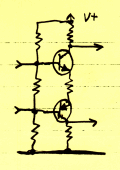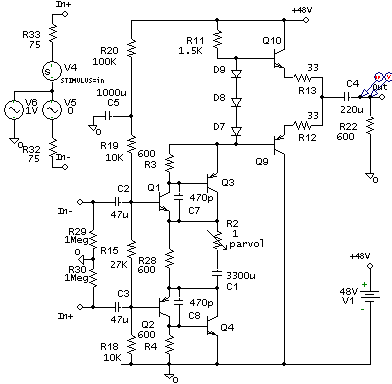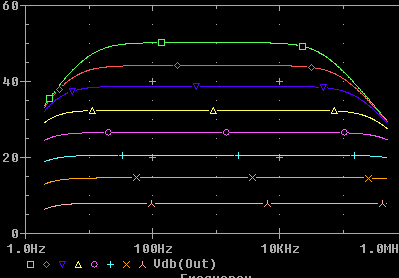There are many ways to skin (or shave) cats. The "instrumentation amp" layouts are not the only way to extract a weak differential signal from common-mode noise.
Believe it or else: this is a differential amplifier:


I found this in a 1967 book. You can take output from either collector, or from both. It isn't good for sensing DC equality, but we don't hear DC. It has some interesting properties for audio. For one: while it is differential, it isn't push-pull. It is very much a single-ended amplifier, even-order distortion is not cancelled.
With a single stage of transistor(s), gain and linearity is not that great. Compounding the transistors with a CE-CE pair is better. Output impedance is high: for driving lines it wants a buffer.
Here's the idea adapted to +48V power:

Power consumption is about 24mA. The buffer could be changed to Class A but if it might see a true 600Ω load then power demand would have to be much higher.
R29 R30 are there mostly for simulation. In real use these would be 6K8 switched to +48V or to ground.
Most caps have a steady DC bias, which will keep electrolytics well-formed. The exception is the input caps: if used with Phantom voltage then these caps must be non-polarized.
Maximum voltage gain is about 62dB and not very linear. I suspect it should not be worked at more than 50dB gain. R2 sets the gain. Values of 3.5, 8, 16, 35, 74, 170, 470, 10K ohms gives gain from 50dB to 8dB in about 6dB steps. These values are really too low to get with a pot, use a switch and fixed resistors.
Gain and frequency response plot:

At the highest gain, response is -1dB at about 20Hz and 20KHz. At lower gains it is better. Possibly too good on the high end: without the 470pFd caps the gain extends beyond 10MHz.
Distortion is not that low but very simple, a mix of even and odd order, generally mostly even and mostly 2nd and below 0.1% except at very high output level (near clipping). It will make 10V in 600Ω, about +22dBm.
Believe it or else: this is a differential amplifier:


I found this in a 1967 book. You can take output from either collector, or from both. It isn't good for sensing DC equality, but we don't hear DC. It has some interesting properties for audio. For one: while it is differential, it isn't push-pull. It is very much a single-ended amplifier, even-order distortion is not cancelled.
With a single stage of transistor(s), gain and linearity is not that great. Compounding the transistors with a CE-CE pair is better. Output impedance is high: for driving lines it wants a buffer.
Here's the idea adapted to +48V power:

Power consumption is about 24mA. The buffer could be changed to Class A but if it might see a true 600Ω load then power demand would have to be much higher.
R29 R30 are there mostly for simulation. In real use these would be 6K8 switched to +48V or to ground.
Most caps have a steady DC bias, which will keep electrolytics well-formed. The exception is the input caps: if used with Phantom voltage then these caps must be non-polarized.
Maximum voltage gain is about 62dB and not very linear. I suspect it should not be worked at more than 50dB gain. R2 sets the gain. Values of 3.5, 8, 16, 35, 74, 170, 470, 10K ohms gives gain from 50dB to 8dB in about 6dB steps. These values are really too low to get with a pot, use a switch and fixed resistors.
Gain and frequency response plot:

At the highest gain, response is -1dB at about 20Hz and 20KHz. At lower gains it is better. Possibly too good on the high end: without the 470pFd caps the gain extends beyond 10MHz.
Distortion is not that low but very simple, a mix of even and odd order, generally mostly even and mostly 2nd and below 0.1% except at very high output level (near clipping). It will make 10V in 600Ω, about +22dBm.



